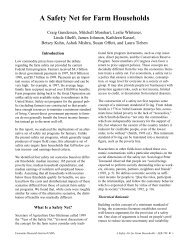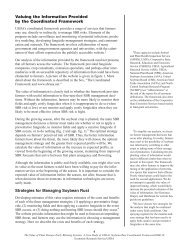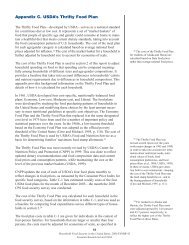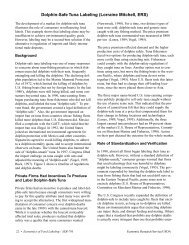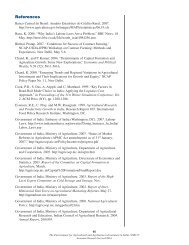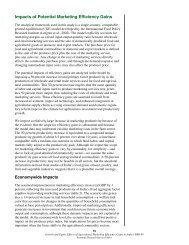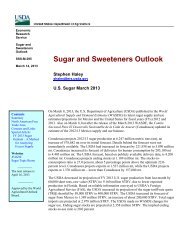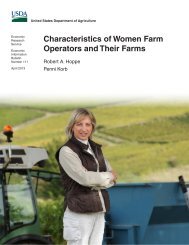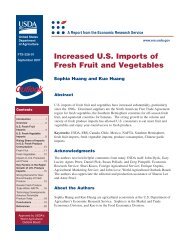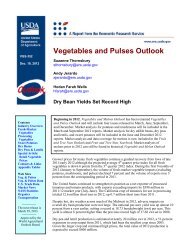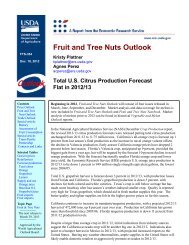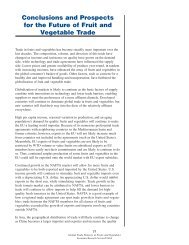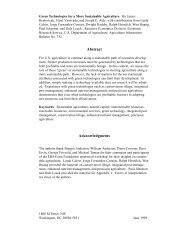Private Investment in Agricultural Research and International..
Private Investment in Agricultural Research and International..
Private Investment in Agricultural Research and International..
Create successful ePaper yourself
Turn your PDF publications into a flip-book with our unique Google optimized e-Paper software.
Table F-5—<strong>Private</strong> <strong>and</strong> public plantation research <strong>in</strong> Malaysia, 1995<br />
Company Crop <strong>Research</strong> SY<br />
requires some qualification. The government <strong>in</strong>vests<br />
directly <strong>in</strong> many of these companies through stock<br />
hold<strong>in</strong>gs managed by the National <strong>Investment</strong> Board<br />
(PNB). PNB holds at least 30-percent ownership <strong>in</strong><br />
three of the largest plantation companies (Golden<br />
Hope, Guthrie, <strong>and</strong> Sime Darby). Two more plantations<br />
are state-owned or state-run (East Plantation<br />
Agency <strong>and</strong> FELDA). The other two plantations with<br />
research programs are United Plantations <strong>and</strong> KL<br />
Kepong. Together, these seven companies are estimated<br />
to have spent about 36.8 million Malaysian<br />
R<strong>in</strong>ggits, or $14.7 million, on R&D <strong>in</strong> 1995. Nearly all<br />
of this was for oil palm research. A small amount went<br />
for rubber, fruit crops, <strong>and</strong> tropical forestry.<br />
Three companies ma<strong>in</strong>ta<strong>in</strong> their own breed<strong>in</strong>g program<br />
<strong>and</strong> produce most of the improved oil palm<br />
seeds (Guthrie, Golden Hope, <strong>and</strong> FELDA). PORIM<br />
itself is restricted by law from sell<strong>in</strong>g seeds to plantations,<br />
although PORIM does provide oil palm seed for<br />
small holders. Due to the cont<strong>in</strong>u<strong>in</strong>g expansion of oil<br />
palm area <strong>and</strong> the need for replant<strong>in</strong>g old trees, there<br />
is a large dem<strong>and</strong> for high-yield<strong>in</strong>g oil palm seeds.<br />
Other plantations are beg<strong>in</strong>n<strong>in</strong>g their own seed production<br />
programs.<br />
<strong>Research</strong> on rubber production is <strong>in</strong>creas<strong>in</strong>gly dom<strong>in</strong>ated<br />
by RRIM, s<strong>in</strong>ce private plantations account for<br />
less than 20 percent of total production <strong>and</strong> their share<br />
1,000 RM/yr<br />
Golden Hope oil palm (70%)<br />
rubber (20%)<br />
cacao, fruit (10%)<br />
10,000 20<br />
Guthrie oil palm 5,000 10<br />
United Plantations oil palm 2,000 4<br />
Sime Darby oil palm 7,300 14<br />
East Plantation Agency oil palm 2,000 4<br />
FELDA 7,500 15<br />
KL Kepong oil palm 2,000 4<br />
Perlis Plantation oil palm<br />
sugarcane<br />
fruits, tobacco<br />
1,000 2<br />
Total private plantation research 36,800 73<br />
Cocoa Board cacao 1,410 5<br />
Palm Oil <strong>Research</strong> Institute of Malaysia oil palm 45,422 130<br />
Rubber <strong>Research</strong> Institute of Malaysia rubber research: 49,000 77<br />
(extension: 21,000 33)<br />
Total public plantation research 95,832 212<br />
Total plantation research<br />
Source: Industry estimates from author's survey.<br />
132,632 285<br />
cont<strong>in</strong>ues to decl<strong>in</strong>e. RRIM allocates about 70 percent<br />
of its scientific <strong>and</strong> technical resources to research <strong>and</strong><br />
about 30 percent to extension. RRIM also conducts<br />
research on rubber post-harvest <strong>and</strong> process<strong>in</strong>g. In<br />
addition, Sime Darby ma<strong>in</strong>ta<strong>in</strong>s its own <strong>in</strong>-house laboratory<br />
<strong>in</strong> tire research. The private sector is represented<br />
<strong>in</strong> RRIM research programs through the Malay Rubber<br />
Producers Council for production research <strong>and</strong> through<br />
the Malay Rubber Product Manufacturers Association<br />
for process<strong>in</strong>g research.<br />
The Malaysian plantation research <strong>in</strong>stitutes also<br />
ma<strong>in</strong>ta<strong>in</strong> formal l<strong>in</strong>kages with research <strong>in</strong>stitutes <strong>in</strong><br />
other countries. Through collaborative research activities,<br />
new sources of technology <strong>and</strong> plant germplasm<br />
are <strong>in</strong>troduced <strong>in</strong>to the Malaysian plantation economy.<br />
RRIM is a member of the <strong>International</strong> Rubber<br />
<strong>Research</strong> <strong>and</strong> Development Board (IRRDB), which<br />
has its secretariat <strong>in</strong> the U.K. IRRDB has sponsored<br />
collections of l<strong>and</strong>races of rubber germplasm. The<br />
world rubber germplasm bank is ma<strong>in</strong>ta<strong>in</strong>ed by RRIM<br />
<strong>in</strong> Malaysia <strong>and</strong> is accessible to all members. RRIM<br />
also supports research <strong>in</strong> other countries. RRIM has<br />
supported research s<strong>in</strong>ce 1938 at a U.K. lab that<br />
focuses on rubber utilization <strong>and</strong> dem<strong>and</strong>. For several<br />
years RRIM also ma<strong>in</strong>ta<strong>in</strong>ed a research lab <strong>in</strong> Brazil<br />
(<strong>in</strong> collaboration with the Brazilian rubber research<br />
system) to study blight diseases; this lab was closed <strong>in</strong><br />
1990.<br />
Economic <strong>Research</strong> Service/USDA <strong>Private</strong> <strong>Investment</strong> <strong>in</strong> <strong>Agricultural</strong> <strong>Research</strong> / AER-805 l 117



